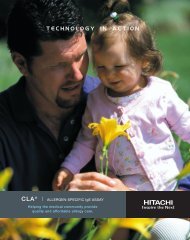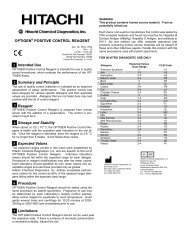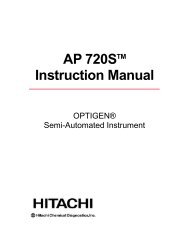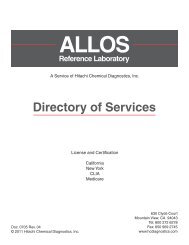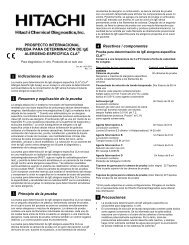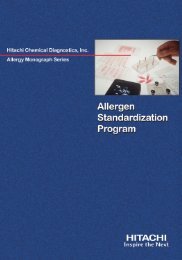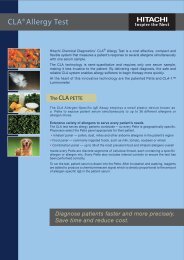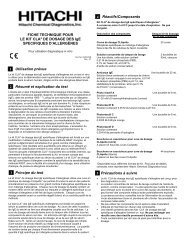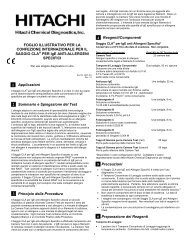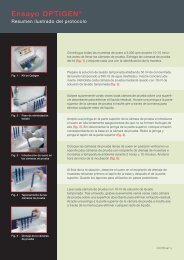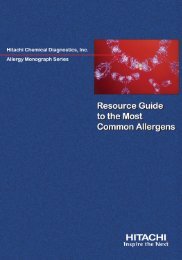CLA® Allergen-Specific IgE Assay Package Insert - Hitachi ...
CLA® Allergen-Specific IgE Assay Package Insert - Hitachi ...
CLA® Allergen-Specific IgE Assay Package Insert - Hitachi ...
You also want an ePaper? Increase the reach of your titles
YUMPU automatically turns print PDFs into web optimized ePapers that Google loves.
• Component reagents of the CLA <strong>Allergen</strong>-<strong>Specific</strong> <strong>IgE</strong> <strong>Assay</strong>kits are provided as matched sets. Do not mix with other kitlot reagent sets.• Bleach contamination has been found to interfere with thetest.Reagent PreparationWash Buffer:• Allow Wash Buffer Concentrate to reach room temperature.Check to see that all salt crystals have dissolved.• Add contents of Wash Buffer Concentrate bottle (50 mL) to950 mL of distilled or deionized water in a clean 1 Lgraduated cylinder or flask. Mix thoroughly.• Transfer solution to Wash Buffer Dispenser.• Once prepared, the Wash Buffer solution can be used for upto 1 month when stored at room temperature (20-25°C) orrefrigerated (2-8°C).<strong>IgE</strong> Antibody:• Allow <strong>IgE</strong> Antibody to reach room temperature before use.Photoreagent Mixture:Prepare Photoreagent Mixture just before use.• Allow Photoreagents A, B, C, and D to reach roomtemperature.• Using a micropipette with disposable tips, combine equalparts of Photoreagent A, B, C, and D in a container. Aminimum of 350 μL of each Photoreagent is required perTest Chamber being assayed, i.e., 1.4 mL ofPhotoreagent Mixture per Test Chamber.• Gently swirl the container to mix.• Photoreagent Mixture should be used within 60 minutes ofmixing.76Storage Instructions• Store kit components at 2-8°C. When stored as directed,the components can be used until the expiration datesprinted on the individual component labels.• Do not freeze kit components.• The Test Chambers are packaged in a plastic bag with amoist sponge. Be sure the plastic bag is sealed properlybefore and after use. When stored in the sealed bag at2-8°C, Test Chambers can be used until the printedexpiration date.8Specimen Collection and PreparationHandle all patient samples and used kit components asrecommended for any potentially infectious human serum orblood specimen. Follow Universal Precautions or otherguidelines as established by your institution when handlingpatient specimens. 9-11The minimum volume of human serum required for each TestChamber is as follows:One 36-allergen Test Chamber, 1.4 mL of serumOne 16-or-fewer-allergen Test Chamber, 0.8 mL of serumCollect a venous blood sample into a 10 mL serum separatortube or red-top tube. Patient need not be fasting. No specialpreparations are necessary. Hemolyzed or lipemic serum mayadversely affect the performance of the CLA <strong>Allergen</strong>-<strong>Specific</strong><strong>IgE</strong> <strong>Assay</strong>. Serum samples may be stored at 2-8°C for up to2one week. For longer periods, store samples frozen at -20°C.Repeated freezing and thawing of serum samples should beavoided. Frozen samples that have been thawed should bethoroughly mixed before centrifugation.9<strong>Assay</strong> ProcedureRefer to the User Guide & Procedural Manual for detailedinstructions on test operation.Materials Provided• CLA <strong>Allergen</strong>-<strong>Specific</strong> <strong>IgE</strong> <strong>Assay</strong>• CLA Equipment Kit,• CLA-1 Luminometer SystemMaterials Required But Not Provided• Graduated cylinder or flask, 1 L, for preparing Wash Buffer• Deionized or distilled waterPreparation of Test Chambers and Patient SamplesRe-centrifuge serum samples for 10 to 20 minutes at2000-3000 x g immediately prior to use. Turn off the centrifugebrake prior to spinning the serum samples.1. Remove Test Chambers (one per specimen) from plastic bag.Reseal plastic bag and return unused Test Chambers torefrigerator.2. With colored grid facing down, label each Test Chamber withappropriate patient identification.3. Record kit lot numbers, panel lot numbers, and patientidentifications.4. Gently tap Test Chamber tip onto an absorbent paper towel toremove any residual liquid from inside the test chamber.ProcedureA. Fill Test Chambers with Serum:1. Attach the 3 cc syringe to top of Test Chamber.2. <strong>Insert</strong> bottom of Test Chamber into tube containingpatient serum. Avoid any precipitate and/or lipid layer.3. Slowly withdraw syringe plunger to draw serum into TestChamber until top thread is covered.B. Plug and Incubate Test Chambers:1. With syringe still attached to top of Test Chamber, inserta white plug into bottom of Test Chamber.2. Remove the syringe and insert black plug into top of TestChamber.3. Incubate upright in workstation rack at room temperaturefor 16 to 24 hours.C. Drain Serum:1. Remove bottom plug from each Test Chamber and placeTest Chamber back in workstation rack.2. Remove top plug from each Test Chamber, allowingserum to drain into workstation reservoir.D. Wash Test Chambers:1. Prime Wash Buffer dispenser until all air bubbles areremoved.2. Attach end of opened dispenser tubing to top of first TestChamber.3. Sequentially wash each Test Chamber once with 10 mLof Wash Buffer. Allow each Test Chamber to draincompletely before proceeding to next step.4. Repeat Step 3 two more times for a total of three washes.Test Chambers must be filled with Antibody Reagentimmediately after washing to avoid drying of threads.



